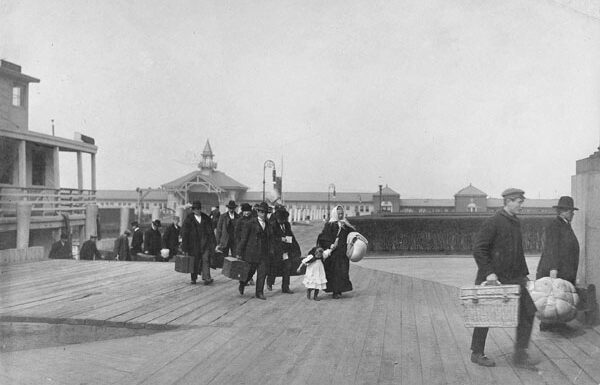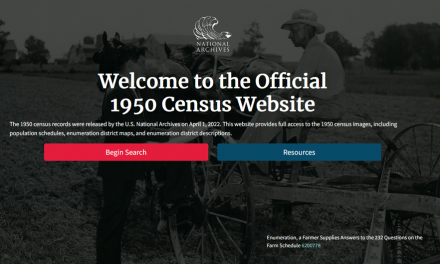Ellis Island stands as an iconic symbol of hope and opportunity, having served as the main gateway for millions of immigrants seeking a new life in the United States. Nestled in New York Harbor, this small island became a pivotal point of entry for immigrants arriving on American shores from 1892 to 1954. Today, Ellis Island is not only a cherished historic landmark but also a goldmine of genealogical treasures, holding a profound significance for those tracing their immigrant ancestors.
From the late 19th century to the mid-20th century, Ellis Island processed an astonishing number of immigrants, providing a gateway to the land of dreams for those in pursuit of better opportunities and escape from hardships in their homelands. During its peak years, this bustling immigration station witnessed the arrival of over 12 million individuals from various corners of the globe, making it the largest and busiest immigrant processing facility in the United States.
Upon arrival at Ellis Island, immigrants underwent thorough medical and legal inspections, ensuring they were fit for entry and complied with immigration laws. Many embarked on the journey with little more than hope in their hearts and dreams of a brighter future. For countless families, Ellis Island became the starting point of a new chapter, leaving behind a legacy of courage, resilience, and the pursuit of the American dream.
Table of Contents
The Importance of Ellis Island Records in Genealogy Research:
Ellis Island records hold immense value for genealogy researchers, serving as a vital link to our immigrant ancestors and the journeys that shaped their lives. The meticulous record-keeping at Ellis Island captured essential details about each immigrant, creating a treasure trove of information waiting to be discovered.
Among the most valuable Ellis Island records are the passenger manifests and ship arrival lists. These documents provide a wealth of genealogical data, including the names of immigrants, their ages, countries of origin, last places of residence, and the names of relatives they were joining in the United States. These details offer a snapshot of an ancestor’s life at the moment of arrival, unlocking the doors to their past and illuminating the paths they traversed.
For genealogy researchers seeking to piece together their family history, Ellis Island records are a priceless resource for bridging the gaps between generations. They can lead to further discoveries, such as naturalization records, census data, and other historical documents that enrich our understanding of our immigrant ancestors’ lives and legacies.
As we step back in time and delve into the rich history of Ellis Island, we embark on a journey of exploration and remembrance. The immigrant experience encapsulated on this tiny island echoes the stories of millions of individuals who shaped the cultural fabric of the United States. For genealogists and family historians, Ellis Island records open a window to the past, connecting us with the brave souls who dared to seek a new life in a land of boundless opportunity.
Navigating Ellis Island Records: Understanding the Collections
Delving into the Ellis Island database is like embarking on a journey through time, retracing the footsteps of millions of immigrants who sought a new beginning in the United States. As you navigate this vast repository of historical records, you’ll encounter a diverse array of documents that provide unique insights into the immigrant experience. Understanding the collections housed in the Ellis Island database is essential for unraveling the stories of your ancestors and gaining a deeper appreciation for their courage and resilience.
Passenger Lists:
At the heart of the Ellis Island database are the passenger lists, meticulously compiled for each ship that arrived at the island. These lists provide a comprehensive record of all passengers on board, including details such as names, ages, gender, occupations, and countries of origin. Additionally, the lists indicate the port of departure, the name of the ship, and the date of arrival, offering a snapshot of the journey taken by our immigrant ancestors.
Ship Manifests:
Closely related to passenger lists, ship manifests offer a more comprehensive overview of the vessel’s cargo, including passengers and crew members. These manifests not only detail the number of passengers in each class (e.g., first, second, or third class) but also identify those detained or deported due to medical or legal reasons. This valuable information can shed light on the conditions faced by immigrants upon arrival.
Immigrant Arrival Records:
Immigrant arrival records represent a treasure trove of data, capturing vital information about the individuals who passed through Ellis Island. These records may include details such as the immigrant’s final destination, the names of relatives they were joining in the United States, and any monetary or medical conditions they carried. Such information provides valuable clues for further genealogical research, enabling you to trace the steps of your ancestors after their arrival in the new land.
Time Periods Covered:
The Ellis Island database spans several decades, covering the peak immigration years from 1892 to 1954. This extensive timeframe encompasses waves of immigrants from Europe, Asia, and other parts of the world, representing a rich tapestry of cultures, languages, and traditions. Whether your ancestors arrived during the great migration of the late 19th century or sought refuge during the tumultuous early 20th century, Ellis Island records offer an opportunity to connect with their personal narratives.
The Wealth of Information:
The wealth of information contained in the Ellis Island records is unparalleled in its historical and genealogical significance. Beyond the basic details of names and dates, these records illuminate the aspirations, struggles, and dreams of our immigrant ancestors. Through these documents, you can gain insights into their occupations, family structures, and reasons for emigrating, as well as witness the extraordinary determination that propelled them to start anew in a foreign land.
Navigating the Ellis Island database is like unearthing buried treasure, one record at a time. Each document serves as a window into the past, painting a vivid portrait of our immigrant ancestors and the transformative journeys they embarked upon. As you piece together the fragments of their lives, you honor their legacy and contribute to a more profound understanding of the diverse and resilient fabric of American society.
Tips for Effective Searches: Finding Your Ancestors
Conducting searches in the Ellis Island database can be an exciting yet challenging endeavor. Unraveling the stories of your immigrant ancestors requires a methodical approach and a keen eye for detail. To maximize your chances of success, consider these practical tips for conducting efficient searches and overcoming common obstacles in your quest to find your ancestors within the Ellis Island records.
Start with Key Details:
Begin your search with essential information about your ancestor, such as their full name, approximate arrival date, and country of origin. Entering specific details at the outset will narrow down your search results and increase the likelihood of finding a match.
Utilize Search Filters:
Take advantage of the search filters provided by the Ellis Island database. These filters allow you to refine your search by passenger name, age, gender, nationality, and ship name. Utilizing filters can streamline your search process and save time.
Be Flexible with Name Spellings:
Names were often misspelled or altered during the immigration process, leading to variations in records. Experiment with different name spellings or consider phonetic equivalents. Nicknames and diminutives may also appear in the records.
Check for Maiden Names:
If you’re searching for female ancestors, remember to check for maiden names, as they may have traveled under their maiden names before marriage. Cross-referencing maiden and married names can help uncover additional records.
Employ Wildcards and Soundex:
When faced with uncertain name spellings, use wildcards (e.g., * or ?) in your search to substitute unknown letters. Additionally, try Soundex searches, a phonetic-based system, to find names with similar sounds but different spellings.
Explore Alternate Arrival Dates:
Consider searching within a range of arrival dates, as discrepancies or transcription errors could result in date variations. Experiment with different date intervals to capture potential matches.
Verify Nationalities and Ports:
Keep in mind that immigrants might have initially settled in a different country or entered the United States through ports other than Ellis Island. Expand your search to include alternate ports and nationalities.
Use Fuzzy Logic:
Some databases offer fuzzy logic search options, which account for minor errors and typos in the data. Enabling this feature can help you find potential matches that might otherwise be overlooked.
Collaborate and Seek Advice:
Join genealogy forums and social media groups to seek advice and collaborate with other researchers. Sharing information and insights can lead to breakthroughs and offer fresh perspectives on your research.
Patience and Persistence:
Genealogy research can be a patient pursuit, and success may not come overnight. Be persistent and patient in your searches, as new records and resources are continuously being digitized and made available.
Document and Review Your Search Process:
Keep detailed records of your search parameters, filters used, and search results. Regularly review your search process to identify any missed opportunities or areas to explore further.
By employing these tips and techniques, you can enhance your search efforts in the Ellis Island database and uncover the hidden stories of your immigrant ancestors. Each discovery is a step closer to connecting with your family’s heritage, painting a vivid picture of their experiences, and preserving their legacy for future generations.
Interpreting Ellis Island Records: Deciphering Passenger Information
As you embark on the journey of exploring Ellis Island records, you’ll encounter a trove of information about your immigrant ancestors, waiting to be deciphered. These invaluable documents provide a snapshot of their arrival to the United States, offering a glimpse into their lives and the circumstances that led them to this new land. To make the most of these records, it’s essential to understand how to interpret the passenger information and discern the details that paint a vivid picture of your ancestors’ experiences.
Passenger Names:
The names of immigrants recorded in Ellis Island records are of paramount importance. Pay close attention to spelling variations and consider how names may have been pronounced in different languages. If you encounter multiple individuals with the same or similar names, cross-reference other details, such as ages and countries of origin, to identify your specific ancestor.
Ages:
Age discrepancies are not uncommon in historical records. Factors such as language barriers, unfamiliarity with Western age conventions, or simple errors during the registration process can lead to variations in reported ages. Be flexible when interpreting ages, especially when searching for younger children or elderly individuals.
Occupations:
The occupation column in Ellis Island records provides insights into your ancestors’ skills and professions. However, be aware that occupations may have been written in the immigrants’ native languages and translated into English during the recording process. As a result, the translated terms may not always align perfectly with modern English equivalents.
Countries of Origin:
The countries of origin mentioned in Ellis Island records are vital clues to your ancestors’ heritage. Keep in mind that national borders have changed over time, so the country names listed might differ from contemporary labels. Historical research and maps can help you identify the correct present-day country.
Significance of Annotations and Codes:
Ellis Island records often include annotations and codes made by immigration officials during the processing of passengers. These notations may indicate specific actions taken, such as medical examinations or legal considerations. Codes could signify quarantine requirements, detainment, or other conditions that affected an immigrant’s entry into the United States.
While these annotations can offer valuable insights into your ancestors’ experiences, understanding them can be challenging. Some annotations may be abbreviations or cryptic notations used by immigration officers. Consult reference materials or guides to help decipher these annotations and codes for a more comprehensive understanding of your ancestors’ journey.
In some cases, annotations may include handwritten notes or remarks added by relatives, fellow travelers, or interpreters. These personal touches can provide glimpses into the emotions and experiences of those arriving in a new country, adding a human touch to the historical records.
As you interpret Ellis Island records, remember that genealogy research is a detective’s work. Piece together various clues, corroborate information from multiple sources, and be open to unexpected discoveries. Each detail you decipher brings you closer to unveiling the stories of your immigrant ancestors, honoring their resilience and contributions to the fabric of American society.
Beyond Ellis Island: Other Ports of Entry and Resources
While Ellis Island holds a prominent place in the history of immigration to the United States, it is just one of many ports of entry that welcomed immigrants from around the world. Exploring other ports and additional resources can unveil new avenues for genealogy research and shed further light on the journeys of our immigrant ancestors. Let’s journey beyond Ellis Island to discover these valuable resources and expand our understanding of our family histories.
Other Ports of Entry:
Castle Garden (Castle Clinton):
Before Ellis Island, Castle Garden, located in Battery Park, New York City, served as the country’s first official immigrant processing center from 1855 to 1890. Records from this period can provide insights into earlier waves of immigration, including those from Europe and Asia.
Angel Island:
Often referred to as the “Ellis Island of the West,” Angel Island Immigration Station processed immigrants arriving on the Pacific Coast, primarily from Asia, from 1910 to 1940. Records from this station offer essential details about Asian immigrants and their experiences.
Port of Boston:
Boston, Massachusetts, was a major port of entry for immigrants, especially during the 19th and early 20th centuries. The Boston Passenger Lists, available at the National Archives and online platforms, document arrivals and departures from this historic port.
Port of New Orleans:
New Orleans, Louisiana, played a significant role in receiving immigrants from Europe and the Caribbean. Passenger lists and records from the Port of New Orleans can offer unique insights into the diverse cultural influences that shaped the region.
Other Ports:
Don’t overlook smaller ports and border crossings. Many immigrants arrived through less-known ports, especially those closer to their final destinations. Consider the locations where your ancestors settled and explore nearby ports for relevant records.
Additional Resources for Tracing Immigrant Ancestors:
Naturalization Records:
Naturalization records document the process by which immigrants became U.S. citizens. These records often contain valuable information, such as birthplaces, dates of arrival, and family relationships. Naturalization records are typically found at local, state, and federal archives.
Passport Applications:
Passport applications can provide further details about an immigrant’s background, including birthdates, occupations, and travel history. The U.S. Department of State maintains passport application records, and they can be accessed through the National Archives.
Immigrant Aid Societies:
Various immigrant aid societies and organizations provided support and assistance to new arrivals. These organizations might have records, photographs, and personal accounts that shed light on your ancestors’ experiences and integration into American society.
City Directories and Census Records:
City directories and census records offer valuable information about an immigrant’s life after arrival. These resources can help trace family movements, occupations, and other vital details over time.
Ethnic Newspapers and Publications:
Ethnic newspapers and publications from the time of immigration can provide insights into the lives of immigrant communities. They often contain articles, announcements, and personal stories that reflect the experiences of our ancestors.
By expanding our research to encompass other ports of entry and additional resources, we enrich our genealogy journey with a deeper understanding of our immigrant ancestors’ lives. Each new discovery contributes to a more comprehensive family history, celebrating the resilience, diversity, and contributions of those who laid the foundation for future generations in the United States.
Case Studies: Uncovering Stories of Immigrant Ancestors
Case Study 1: The Mystery of Maria’s Arrival
Maria, a genealogy enthusiast, was determined to learn more about her great-grandmother, a Ukrainian immigrant. The family had little information beyond her name and approximate arrival date. Maria began her search by using Ellis Island records, experimenting with different name spellings and filters. After persistent efforts, she discovered a passenger manifest that matched her great-grandmother’s name, providing essential details about her arrival on a steamship from Hamburg. The record revealed Maria’s great-grandmother was accompanied by her sister and had listed their cousin as the contact in the United States. This discovery led Maria to explore naturalization records, where she found her great-grandmother’s application, complete with a photograph and her heartfelt oath of allegiance. Through this journey, Maria pieced together the story of her ancestor’s brave solo voyage, leaving behind her homeland to build a new life in America.
Case Study 2: Reuniting Long-Lost Cousins
John and Emma, distant cousins separated by time and distance, both independently embarked on genealogy research. They each knew fragments of their shared family history but were unaware of each other’s existence. Both John and Emma utilized Ellis Island records and other port arrival documents to trace their common ancestors’ immigration. Through collaborative efforts in online genealogy forums, they discovered their shared lineage and connected the dots. A ship manifest indicated that their grandparents arrived on the same ship, just a few weeks apart, unbeknownst to both sides of the family. The joy of uncovering their familial bond and reuniting after generations apart brought a renewed sense of belonging and a stronger connection to their shared heritage.
Case Study 3: A Twist in the Tale
David, researching his Italian roots, encountered a curious roadblock in his Ellis Island searches. Despite having detailed information about his great-grandfather, he could not find any records under the expected name. Frustrated but determined, David decided to search for alternate name spellings. To his surprise, he found a manifest that listed his great-grandfather’s name as “Domenico” instead of “Domenic.” This revelation opened new doors of research. David delved into city directories and census records, uncovering additional records that referred to his great-grandfather as “Dominick.” The realization that his ancestor had adopted an Americanized name shed light on the challenges immigrants faced in assimilating into a new culture while preserving their heritage.
These case studies illustrate the power of Ellis Island records and other genealogy resources in unearthing the hidden stories of our immigrant ancestors. Each success story showcases the practical application of the techniques discussed earlier, such as being flexible with name spellings, utilizing search filters, exploring additional resources beyond Ellis Island, and collaborating with other researchers. Through dedication, persistence, and a willingness to explore various avenues, these individuals pieced together the puzzle of their family’s past, enriching their family histories with poignant tales of courage, resilience, and the pursuit of the American dream.
As we continue to delve into the lives of our immigrant ancestors, we celebrate the countless untold stories that await discovery. Each case study demonstrates that genealogy research is a transformative journey, weaving together the threads of our past and connecting us with the enduring legacies of those who came before us. The search for our roots is an ever-evolving process, and with each new revelation, we honor the indomitable spirit of our immigrant ancestors and the timeless stories they have left for us to uncover.




